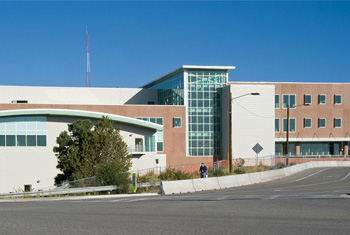 JBH Northern New Mexico crews completed the mechanical piping and ventilation installation in the Mass Spectrometer and Radiological Chemistry Laboratories along with installations in the Trace Elements Laboratories #2 and #3 of LANL’s newest facility, RLUOB. The article below is reprinted with permission from the owner detailing the project’s completion and celebratory LEED Gold Certification.
JBH Northern New Mexico crews completed the mechanical piping and ventilation installation in the Mass Spectrometer and Radiological Chemistry Laboratories along with installations in the Trace Elements Laboratories #2 and #3 of LANL’s newest facility, RLUOB. The article below is reprinted with permission from the owner detailing the project’s completion and celebratory LEED Gold Certification.
LOS ALAMOS, New Mexico, June 13, 2012—Los Alamos National Laboratory’s newest facility, the Radiological Laboratory Utility Office Building (RLUOB), is also its first to achieve both the Leadership in Energy and Environmental Design (LEED) status and LEED Gold certification from the U.S. Green Building Council (USGBC).
From its robust design to its advanced scientific equipment, RLUOB is essential to the Laboratory’s national security mission in support of the National Nuclear Security Administration’s (NNSA) nuclear weapons program. At more than 200,000 square feet, this building is the only radiological facility within the Department of Energy to have attained LEED Gold, which contributes to NNSA’s achievement towards the high performance sustainable building goals outlined in Executive Order 13514, Federal Leadership in Environmental, Energy, and Economic Performance.
“As we celebrate RLUOB being completed almost one year ahead of schedule and having achieved LEED certification at the Gold level, we approach our plutonium mission at Los Alamos and NNSA with a great sense of achievement,” said Don Cook, NNSA’s deputy administrator for defense programs. “RLUOB adds a major component to NNSA’s plutonium support capability and RLUOB demonstrates our commitment in helping to deliver President Obama’s nuclear security agenda which includes ensuring the safety, security and effectiveness of the nuclear deterrent without testing.”
The facility contains laboratories for analytical chemistry and materials characterization of special nuclear material, along with space for offices, training and emergency operations. Its multi-functional purpose makes RLUOB a unique project for which LEED certification was sought.
“LEED certification was a huge goal and one we sought from the very beginning of this project,” said Laboratory Director Charlie McMillan. “It’s an important step forward, allowing us to advance national security science in modern, safer, more efficient infrastructure.”
The Laboratory’s project team and its contractor partners, especially in coordination with Jacobs Engineering, focused on green design and construction in LEED categories, such as sustainable sites, water efficiency, energy and atmosphere, materials and resources, indoor environmental quality and innovation in design. RLUOB’s features include:
- Building envelope design (orientation, materials and insulation) yielded a 20 percent improvement in energy performance;
- Incorporation of building materials with 24 percent recycled content;
- Diversion of 72 percent of construction-generated materials through reuse, recycle and salvage;
- Roofing comprised of 93 percent highly-reflective materials to reduce heat island effects;
- High efficiency, gas-fired hot water boilers, air-cooled chillers, thermal storage systems and variable frequency drives for compressors, fans and pumps;
- Energy efficient lighting for interiors, exteriors, process glove boxes and fume hoods;
- Water efficient fixtures resulting in 30 percent reduction in usage;
- Low emission paints and carpeting for improved indoor air quality;
- Landscaping that doesn’t require permanent irrigation;
- Enhanced building system commissioning; and
- Comprehensive transportation alternatives, including public transportation, bicycle storage and changing rooms, and a refueling station for government vehicles using alternative fuels.
“RLUOB’s LEED certification demonstrates tremendous leadership in green building,” says Rick Fedrizzi, president and CEO of USGBC. “The urgency of our mission has challenged the industry to move faster and reach further than ever before, and RLUOB serves as a prime example of just how much we can accomplish.”
